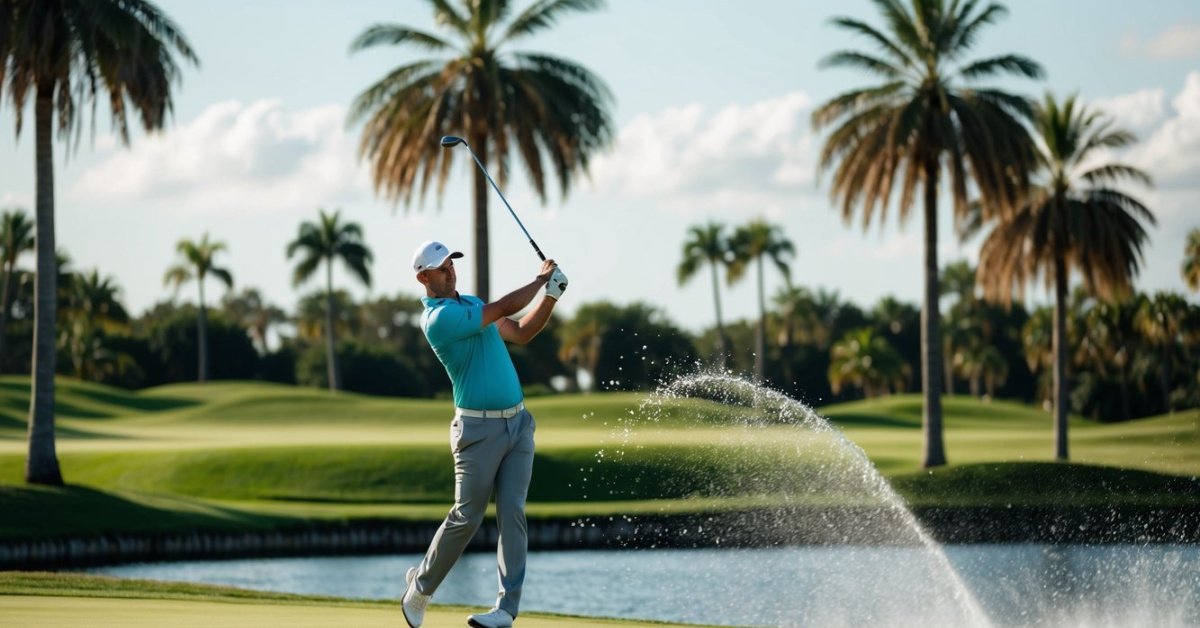Ever wondered if a tiny golf ball could actually be lethal? You might chuckle at the thought, but when that little sphere is rocketing towards you at high speeds, it’s no laughing matter. In this article, we’ll delve into the surprising dangers lurking on the fairways.

You’ll discover how a golf ball can turn from a game accessory into a dangerous projectile. We’ll explore real-life incidents, the physics behind the impact, and what you can do to stay safe on the green. So, grab your clubs, and let’s tee off into the world of golf ball safety.
The Surprising Risk: Can a Golf Ball Kill You?
As an avid golfer with impressive skills on the green, you’re always aware of the critical importance of safety on the course. But you might not have considered one particular question in depth: can a golf ball actually prove lethal?
The answer is more alarming than you might expect. Golf balls are designed for high velocity, and when they’re sent flying at speeds that can exceed 150 miles per hour, they embody a significant force. Combine that force with a direct impact trajectory and the results can be severe.
Let’s look at some facts. A golf ball typically weighs about 45.93 grams and can reach speeds of up to 200 miles per hour in a professional’s drive. At these speeds, the ball’s impact can deliver a blow with over 2,000 pounds of force per square inch. To put that in perspective, it’s similar to the kinetic energy of a bullet. Imagine the gravity of a misdirected shot becoming a life-threatening projectile.
Here’s a breakdown of the potential force:
| Speed (mph) | Force (pounds of force per square inch) |
|---|---|
| 150 | 1,500 |
| 200 | 2,000 |
In the rare event of being struck in a vulnerable spot such as the temple or behind the ear, the chances of a fatal injury increase. Incidents have occurred, though they are certainly not commonplace. Every golfer, irrespective of handicap, bears the responsibility of ensuring that the course is clear before swinging.
Practically speaking, you’re more likely to be hit by a stray ball on a congested course or during a tournament where multiple players are active. It’s imperative to maintain awareness—not only of your own shots but also of those around you.
Always shout ‘Fore!’ to warn others of an errant shot—it’s not just etiquette; it’s a vital safety measure. Never underestimate the distance and power you can achieve with a good swing. After all, as a low handicapper, you’ve got the skill to make the ball go long. Just be sure it’s going in the right direction.
Real-Life Incidents: Golf Ball Accidents That Turned Deadly
« What Happens If Golf Ball Hits Car: Damage and Insurance Must-Knows
Most Golf Balls Stacked: Secrets from Pros to Beat the Record »
As an avid golfer with a sharp eye for the game’s intricacies, you’re well aware of golf’s leisurely pace and gentlemanly demeanor. However, tragedy can occur even amidst such serene settings. Over the years, there have been several distressing incidents where golf balls have turned lethal.
In one noted case, a golf ball struck a man who was merely enjoying his round. Unbeknownst to his playing partners, the ball caused a fatal intracranial hemorrhage due to the sheer force of the impact. This grim example underscores that the risks aren’t limited to just those swinging the clubs, but can also affect bystanders or those in adjoining fairways.
Another incident involved a young golfer hit by an errant ball. He suffered severe brain injuries leading to his untimely death. This tragedy was a stark reminder that youth and vitality are no shields against the dangers of a high-velocity golf ball.
| Year | Incident Summary | Result |
|---|---|---|
| 2016 | Man struck in temple by stray golf ball | Fatal intracranial hemorrhage |
| 2019 | Teenager in golf clinic hit in back of head | Fatal brain injury |
Such events have led to calls for improved safety measures on courses worldwide. These include better-designed course layouts with increased distances between parallel fairways and enhanced warning systems.
As you continue to enjoy the challenge of shaving strokes off your handicap, remember to always stay alert of your surroundings. Never assume you’re safe just because you’re out of what you consider the typical line of fire. Shout “Fore!” louder than you might think necessary and listen for the calls of others. It’s your — and everyone else’s — responsibility to prevent these rare but devastating accidents.
Understanding the Physics: The Force and Impact of a Golf Ball
When you’re lining up your shot on the fairway or getting ready to take a swing at the tee, it’s not just your technique that plays a role in where that ball ends up — it’s physics. At the moment of impact, when your club’s head meets the golf ball, a tremendous amount of force is exerted. That little white ball can take off at speeds exceeding 150 miles per hour.
The force applied to a golf ball is a product of the club speed and the mass of the club head. All this momentum is transferred to the golf ball in a fraction of a second. This is why, when you swing, that focus on a smooth follow-through is as crucial as the accuracy of the swing itself.
Here’s what happens in that split-second interaction:
- The golf ball compresses on impact.
- Kinetic energy from the club is transferred to the ball.
- The ball deforms and stores energy.
- It then releases this energy as it leaps off the clubface.
A typical drive delivers a force of nearly 2,000 pounds to the ball. To give you an idea of how much energy we’re talking about, consider that this amount of force can lift a small car momentarily. This energy is what makes it possible for the ball to cover great distances.
However, it’s that very energy that poses a risk if the ball goes astray and finds a target other than the open fairway. At such high speeds, if a golf ball strikes a person, it can result in significant injury. The critical variables are:
- Speed of the ball
- Point of impact
- Distance from the struck person
A golf ball can cause damage and injury, particularly if it hits someone at a close range and in a vulnerable spot. It’s a reminder to keep your senses sharp and to practice not only your swing but also your awareness of your surroundings on the course. Always announce your shots with a loud “Fore!”, giving anyone in the ball’s path time to react and protect themselves, fostering a safer environment for everyone to enjoy the game you love.
The Hidden Dangers: Hazards on the Fairways
You know the thrill of teeing off with a powerful swing, the satisfaction of watching your ball soar down the fairway. But do you ever think about the risks lurking on the course? Golf may not be a contact sport, but it has its fair share of dangers.
First off, stray balls are more than just an annoyance; they’re a hazard. Even as a low handicapper, nobody’s immune to the occasional slice or hook. A stray ball can easily catch a fellow golfer off guard, potentially leading to serious injury. There’s a reason why Alertness and proper etiquette, like yelling “Fore!” when needed, are crucial.
Then there’s the issue of golf carts. Sure, they’re a fun way to get around the course, but they can be deceptively dangerous. Rough terrain, sharp turns, and even distraction can lead to Accidents or rollovers. Always operate carts with caution, keeping your speed reasonable especially in poor weather conditions.
Don’t forget about the natural elements of the course itself. Water hazards aren’t just bad for your score; they can pose a drowning risk if you’re not careful, especially for non-swimmers. Deep bunkers and uneven ground can also create the perfect storm for twisted ankles or falls, especially for those playing on older courses with more rugged features.
When you’re out on the fairways, always stay aware of these dangers. It’s more than just about following the rules of the game; it’s about keeping you and your fellow golfers safe. So, the next time you’re facing down a long par 5, remember that the challenge isn’t only in landing your ball on the green, but also making sure everyone walks off the course unharmed. Keep safety your number one priority, just as much as sinking that birdie putt.
Staying Safe on the Green: Tips for Golf Ball Safety
As you continue honing your skills and lowering that handicap, it’s crucial to remember that golf ball safety is paramount. An errant ball can spell disaster, so maintaining vigilance is not just about etiquette—it’s a necessity.
First and foremost, communication with your fellow golfers is key. Always announce your intentions before taking a shot. If your ball veers towards other players or spectators, don’t hesitate—yell “Fore!” as loud as possible. It’s a simple word, but it can avert serious injuries.
Keep an eye on the game around you, not just your own. Balls can come from any direction. Be mindful of other players teeing off or hitting long shots that might encroach on your vicinity. By staying aware, you reduce your risk, and you uphold the safety of others as well.
Use protective gear. Sunglasses and hats aren’t just for style or blocking out the sun—they also offer a degree of protection for your face and eyes. Consider wearing these whenever you’re out on the course. Accidents happen, and while a golf ball might not always be lethal, it can cause significant harm.
Always watch your swing speed and control. Your mastery of the golf swing is a potent tool. The harder you hit the ball, the farther—and potentially more dangerous—it can go. Learning to control your swing to suit your environment is essential, especially on crowded courses or when playing near roads and footpaths.
Golfing is about enjoyment and improving your game, but it’s also a space where safety should never take a back seat. Keep these tips in mind every time you step onto the green, and encourage your golfing companions to do the same. In fostering a culture of safety, you’ll ensure that every round is as enjoyable as it is secure.
Conclusion: Golf Ball Safety – It’s No Laughing Matter
So there you have it—you’re now armed with the knowledge of just how critical golf ball safety is. Remember, it’s not just about your own safety but also about looking out for your fellow players. Next time you’re on the course, keep those communication lines open and don’t hesitate to shout “Fore!” when needed. Embrace the use of protective gear and be mindful of your swing speed. By doing your part to maintain a safe environment, you’re not just playing a game; you’re respecting the well-being of everyone around you. Stay safe and enjoy the game!
Frequently Asked Questions
What is the primary focus of the article?
The article primarily focuses on the importance of golf ball safety and the measures that can be taken to prevent injuries on the golf course.
Why is communication important in golf?
Communication is crucial in golf to alert fellow golfers of potential dangers, like stray balls. The customary shout of “Fore!” is a widely recognized warning used to prevent accidents.
What protective gear is recommended for golfers?
Golfers are advised to wear sunglasses and hats as protective gear to shield themselves from both stray golf balls and the sun’s rays.
How can controlling swing speed contribute to safety?
Controlling swing speed can minimize the risk of losing control of the ball, thereby reducing the chance of hitting someone and contributing to overall safety on the course.
What can be done to promote a culture of safety in golf?
Promoting a culture of safety in golf involves consistent communication, using the proper protective gear, being aware of one’s surroundings, and controlling swing techniques to prevent accidents.










